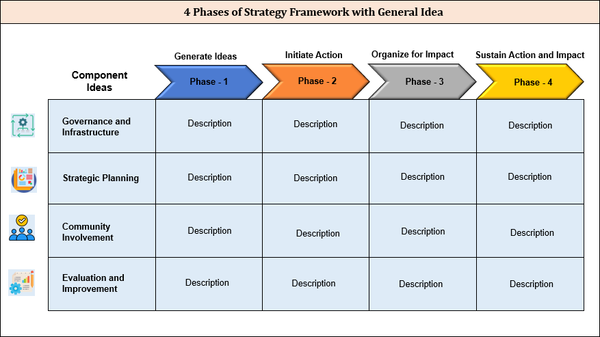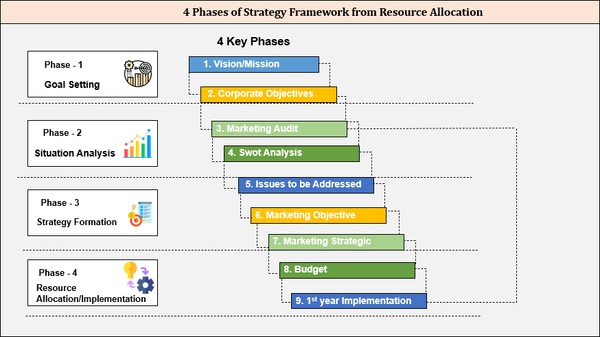4 Phases of Strategy
What is Strategy Management?
The term ‘strategy management is used to describe the process by which an organization formulates, implements, and monitors the progress of its business goals. A good strategy management process will help an organization to identify and exploit opportunities, while also protecting against risks.

The first step in strategic management is goal setting. An organization must identify what it wants to achieve and then set realistic and achievable goals. Once the goals have been set, the next step is to develop a plan of action. This plan should outline how the organization intends to achieve its goals and should take into consideration any risks that might be encountered.
Once the plan has been put into action, it is important to monitor progress and adjust where necessary. This includes regular review and assessment of the plan to ensure that it is still on track to achieving the desired results.
The benefits of a well-executed strategy management process are clear. By taking the time to plan and execute a business strategy, an organization can increase its chances of success and ensure that it remains competitive in the marketplace.
The main objectives of Strategy Management are to ensure that the company's resources are used in a way that best achieves its goals and objectives, and to make sure that the company can adapt to changes in the external environment.
There are Four Main Steps in the Strategy Management process:
- Formulation of the company's goals and objectives
- Identification of the company's core competencies
- Development of the company's strategies
- Implementation of the company's strategies.
The Components of a Strategy Statement
A strategy statement is composed of three essential components:
- The mission statement.
- The vision statement.
- The values statement.
The mission statement defines the company’s overall purpose and aspirations. The vision statement outlines what the company wants to achieve in the future. The values statement captures the company’s core beliefs.
The statement should be clear, concise, and easy to understand. It should also be achievable and aligned with the company’s goals.
The strategy statement is the foundation of the company’s strategic planning process. It sets the stage for the development of specific strategies that will achieve the company’s objectives. The statement should be reviewed and updated regularly to ensure that it remains relevant and responsive to the ever-changing business environment.
The Importance of Strategic Management.
It is a process that helps organizations to assess their current situation, identify their goals, and develop plans to achieve those goals.
Strategic management is important for several reasons. First, it helps organizations to clarify their mission and vision. Second, it provides a framework for decision-making. Third, it helps organizations to allocate resources and select the best course of action. Fourth, it helps organizations to monitor and evaluate their progress. Finally, it helps organizations to adapt to change.
Thus, we can see that strategic management is a crucial process for organizations. It helps them to assess their current situation, identify their goals, and develop plans to achieve those goals. It also provides a framework for decision-making, helps organizations to allocate resources, and aids in monitoring and evaluating progress.

The Four Phases of the Strategic Management Process.
The strategic management process is a method used by organizations to make decisions about their future direction. The process is composed of four main phases: planning, implementation, monitoring, and evaluation.
Planning
The first phase, planning, is when the organization sets its goals and objectives. This is done through a variety of means, such as SWOT analysis, business model analysis, and environmental scanning.
Implementation
The second phase, implementation, is when the organization puts its plan into action. This phase is often subdivided into sub-phases, such as project planning, resource allocation, and task assignment.
Monitoring
The third phase, monitoring, is when the organization monitors the progress of its plan and adjusts as necessary. This phase is important in ensuring that the plan is on track and that goals are being met.
Evaluation
The fourth and final phase, evaluation, is when the organization evaluates the results of its actions and decides whether the plan was successful. This phase is important to learn from the past and improve future planning.
The Benefits of the Strategic Management Process.
Strategic management is the process of making decisions about an organization's goals, resources, and policies. The goal of strategic management is to create value for the organization.
The benefits of the strategic management process are many and varied, but the most important ones are listed below:
- It helps organizations to make better decisions about where to allocate resources.
- It helps organizations to make better decisions about how to respond to opportunities and threats.
- It helps organizations to better understand their strengths and weaknesses.
- It helps organizations to better understand the competitive environment.
- It helps organizations to better understand the needs and wants of customers.
- It helps organizations to better understand the impact of technology on their business.



